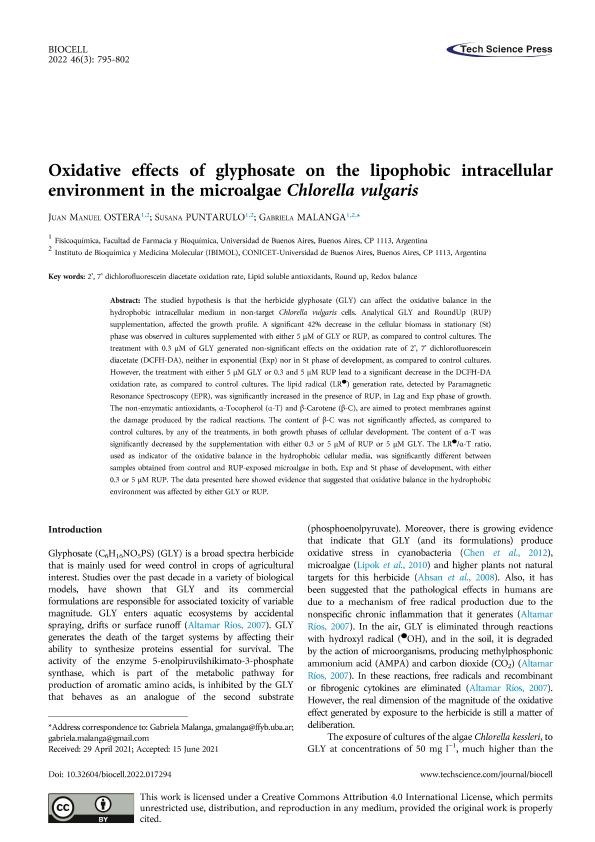Mostrar el registro sencillo del ítem
dc.contributor.author
Ostera, Juan Manuel

dc.contributor.author
Puntarulo, Susana Ángela

dc.contributor.author
Malanga, Gabriela Fabiana

dc.date.available
2023-07-14T11:40:17Z
dc.date.issued
2022-02
dc.identifier.citation
Ostera, Juan Manuel; Puntarulo, Susana Ángela; Malanga, Gabriela Fabiana; Oxidative effects of glyphosate on the lipophobic intracellular environment in the microalgae Chlorella vulgaris; Instituto de Histología y Embriología; Biocell; 46; 3; 2-2022; 795-802
dc.identifier.issn
0327-9545
dc.identifier.uri
http://hdl.handle.net/11336/203924
dc.description.abstract
The studied hypothesis is that the herbicide glyphosate (GLY) can affect the oxidative balance in the hydrophobic intracellular medium in non-target Chlorella vulgaris cells. Analytical GLY and RoundUp (RUP) supplementation, affected the growth profile. A significant 42% decrease in the cellular biomass in stationary (St) phase was observed in cultures supplemented with either 5 µM of GLY or RUP, as compared to control cultures. The treatment with 0.3 µM of GLY generated non-significant effects on the oxidation rate of 2’, 7’ dichlorofluorescein diacetate (DCFH-DA), neither in exponential (Exp) nor in St phase of development, as compared to control cultures. However, the treatment with either 5 µM GLY or 0.3 and 5 µM RUP lead to a significant decrease in the DCFH-DA oxidation rate, as compared to control cultures. The lipid radical (LR•) generation rate, detected by Paramagnetic Resonance Spectroscopy (EPR), was significantly increased in the presence of RUP, in Lag and Exp phase of growth. The non-enzymatic antioxidants, α-Tocopherol (α-T) and β-Carotene (β-C), are aimed to protect membranes against the damage produced by the radical reactions. The content of β-C was not significantly affected, as compared to control cultures, by any of the treatments, in both growth phases of cellular development. The content of α-T was significantly decreased by the supplementation with either 0.3 or 5 µM of RUP or 5 µM GLY. The LR•/α-T ratio, used as indicator of the oxidative balance in the hydrophobic cellular media, was significantly different between samples obtained from control and RUP-exposed microalgae in both, Exp and St phase of development, with either 0.3 or 5 μM RUP. The data presented here showed evidence that suggested that oxidative balance in the hydrophobic environment was affected by either GLY or RUP.
dc.format
application/pdf
dc.language.iso
eng
dc.publisher
Instituto de Histología y Embriología

dc.rights
info:eu-repo/semantics/openAccess
dc.rights.uri
https://creativecommons.org/licenses/by/2.5/ar/
dc.subject
DICHLOROFLUORESCEIN DIACETATE OXIDATION RATE
dc.subject
LIPID SOLUBLE ANTIOXIDANTS
dc.subject
REDOX BALANCE
dc.subject
ROUND UP
dc.subject.classification
Bioquímica y Biología Molecular

dc.subject.classification
Ciencias Biológicas

dc.subject.classification
CIENCIAS NATURALES Y EXACTAS

dc.title
Oxidative effects of glyphosate on the lipophobic intracellular environment in the microalgae Chlorella vulgaris
dc.type
info:eu-repo/semantics/article
dc.type
info:ar-repo/semantics/artículo
dc.type
info:eu-repo/semantics/publishedVersion
dc.date.updated
2023-07-05T12:08:03Z
dc.journal.volume
46
dc.journal.number
3
dc.journal.pagination
795-802
dc.journal.pais
Argentina

dc.description.fil
Fil: Ostera, Juan Manuel. Consejo Nacional de Investigaciones Científicas y Técnicas. Oficina de Coordinación Administrativa Houssay. Instituto de Bioquímica y Medicina Molecular. Universidad de Buenos Aires. Facultad Medicina. Instituto de Bioquímica y Medicina Molecular; Argentina
dc.description.fil
Fil: Puntarulo, Susana Ángela. Consejo Nacional de Investigaciones Científicas y Técnicas. Oficina de Coordinación Administrativa Houssay. Instituto de Bioquímica y Medicina Molecular. Universidad de Buenos Aires. Facultad Medicina. Instituto de Bioquímica y Medicina Molecular; Argentina
dc.description.fil
Fil: Malanga, Gabriela Fabiana. Consejo Nacional de Investigaciones Científicas y Técnicas. Oficina de Coordinación Administrativa Houssay. Instituto de Bioquímica y Medicina Molecular. Universidad de Buenos Aires. Facultad Medicina. Instituto de Bioquímica y Medicina Molecular; Argentina
dc.journal.title
Biocell

dc.relation.alternativeid
info:eu-repo/semantics/altIdentifier/doi/https://doi.org/10.32604/biocell.2022.017294
Archivos asociados
